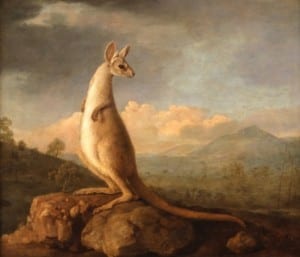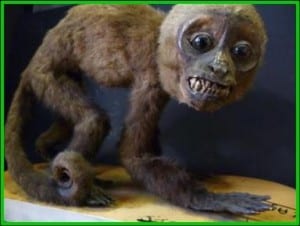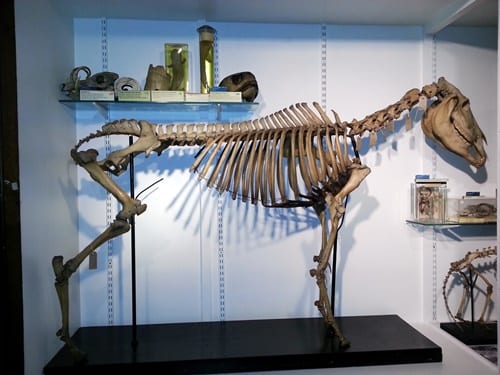Specimen of the Week 187: The Tamandua Hand
By Will J Richard, on 11 May 2015
Hello! Will Richard here, bringing you another Specimen of the Week.
This month I’ve decided to start with a reading from one of my poems.
I call this “Specimen”.
Ahem ahem.
The hand is in the jar.
The hand of a tamandua?
It might seem quite bleak as my choice for this week
but read on and you might just say “ahhh!”
Or you might not.
Either way, this week’s specimen of the week is…
Rock Room Slade School Takeover – Part 3
By Nick J Booth, on 5 May 2015
This Friday (May 8th) between 1 – 5pm the Rock Room will host its annual Slade School takeover. This is the third instalment of the joint UCL Museums and Slade School of Fine Art project (see a blog on the last one here) which has seen staff and students from the Slade install art works that include sculpture, painting and various mixed media (including cheese, fish and other foodstuffs) into the Rock Room.
As with past years I have no idea what the artists will be bringing to display in the Museum. Read the rest of this entry »
The earliest Strange Creatures: Europe’s first meetings with marsupials
By Jack Ashby, on 5 May 2015
There is a popular British colonial narrative in which Captain James Cook “discovered” Australia in 1770, as demonstrated by this Google autofill:
In reality, not even Cook thought this was true. Australia had been known by the French, Portuguese, Spanish and Dutch (hence its original European name “New Holland”, which Cook himself used) for at least two hundred years before Cook landed in the southeast of the country on his ship HMS Endeavour. Obviously Indigenous Australians and their neighbours also had been there for around 50,000 years.

The Kongouro from New Holland (Kangaroo), George Stubbs (1772). ZBA5754 (L6685-001). National Maritime Museum, Greenwich, London
Our current exhibition Strange Creatures: The Art of Unknown Animals explores how newly discovered animals are communicated to the public back home. It is is centred around a painting that resulted from that voyage of Cook’s – a kangaroo by George Stubbs. This is the first painting of an Australian animal in Western art. As I wrote in the exhibition text:
This painting helped begin Europe’s relationship with Australian wildlife. Commissioned by legendary naturalist Joseph Banks, painted by celebrated animal artist George Stubbs, and based on findings from Captain Cook’s famous voyage, this kangaroo truly captured the country’s imagination.
Stubbs’ image became the archetype for representations of kangaroos for decades – reproduced and refigured prolifically. It may not be anatomically perfect, but this is how Britain came to know the kangaroo.
It is an emblem of the age of exploration at the historical threshold of the European occupation of Australia. Nothing was ever the same again.
Here I’d like to explore some of the meetings between Europeans and Australiasian marsupials that preceded Cook’s visit. Read the rest of this entry »
Specimen of the Week: Week 186
By Tannis Davidson, on 4 May 2015
 Sometimes a specimen can tell you a little. Sometimes it can tell you a lot. There has been much written on this blog about the perils and pitfalls of museum documentation. Sometimes there is no information with a specimen – no accession record, no acquisition information, no species name and (occasionally) no specimen. Objects get lost and misplaced. Historical records are incomplete or indecipherable. Specimen labels become separated from their object.
Sometimes a specimen can tell you a little. Sometimes it can tell you a lot. There has been much written on this blog about the perils and pitfalls of museum documentation. Sometimes there is no information with a specimen – no accession record, no acquisition information, no species name and (occasionally) no specimen. Objects get lost and misplaced. Historical records are incomplete or indecipherable. Specimen labels become separated from their object.
Alternatively, some specimens may have (dare I say it) too much information which may include multiple numbers, several differing records, erroneous taxonomic information or questionable identifications.
Caring for a collection entails many things but first and foremost is to identify the collection itself – through all possible means including the consolidation of any (and all) associated information. When luck prevails, one may find a scrap (literally) of information which ties it all together – a word or two which allows a specimen to be given a name, a record, a life!
Recently while going through the bird drawers, I came across an unaccessioned skull and mandible together with its associated information (unclear object number, outdated taxonomic name) including a small piece of paper with two words: “El Turco”. This week’s Specimen of the Week is…
Read the rest of this entry »
The world’s rarest skeleton returns to the Grant Museum
By Jack Ashby, on 1 May 2015
Can you spot the difference between these two photos?
They both depict the world’s rarest skeleton – that of the quagga, an extinct not very stripy kind of zebra – the UK’s only articulated quagga lives here at the Grant. There are only six (or possibly five) other skeletons in existence. The top picture was taken in February, on the day that she left the Museum to undergo major treatment for the ills that resulted from over a hundred years of grime and questionable mounting. The second was taken on Tuesday, when she returned to us. The quagga (and our rhino) were the biggest single tasks for our massive conservation project Bone Idols: Protecting our iconic skeletons, working to save 39 of our biggest and most significant specimens for the long term future.
Hopefully you’ve spotted eveything that specialist bone preparator Nigel Larkin has done to prolong the “shelf life” of the quagga… Read the rest of this entry »
Underwhelming Fossil Fish of the Month: April 2015
By Mark Carnall, on 30 April 2015
As we know from the documentary The Devil Wears Prada, fashion is really important because the styles we see on the catwalk today are ridiculous things that nobody in their right mind would wear but then Anne Hathaway dresses nicely and that helps her write Harry Potter and get a boyfriend. How is this relevant to this month’s underwhelming fossil fish of the month, our monthly journey through the museum drawers of uninspiring fossil fish? Well, I’m going to let you into a little secret, a lot* of fashion designers are also keen palaeontologists and if you pay close attention you’ll see a lot of styles from deep time come back into fashion time and time again.
/Cue segue.
This month’s fossil fish is no exception. Some scholars** speculate that this month’s fossil fish inspired the more over-compensatory codpiece design of the 15th and 16th centuries so if you’re prone to tittering or fainting then do brace yourself for disappointment in 5- 4- 3- 2- 1.
The Museum is Where the People Are – vote for us now
By Jenny M Wedgbury, on 29 April 2015
VOTE NOW http://bit.ly/connectpureevil
Old master prints, drawings of flayed bodies, mysterious things in glass jars, extinct animal skeletons, glittery minerals and rocks, amulets and charms from ancient Egypt: UCL Museums and Collections are a treasure trove of the awe inspiring and unusual. But we don’t just think of ourselves as being a collection of objects fixed to one space and place, we believe that the Museum is where the people are and we want to take the spirit of our collections off site for the Museums at Night event on 30 and 31 October. Read the rest of this entry »
Specimen of the Week: Week 185
By Jack Ashby, on 27 April 2015
 This week I’m honouring a mammal that we can link to two significant factors in my life recently. First, it’s an Australian hopping marsupial, as are kangaroos. Our current Strange Creatures exhibition centres around Europe’s first painting of a roo – by George Stubbs. Secondly, I’ve been in Australia for the last few weeks doing fieldwork with the Australian Wildlife Conservancy, and my first task was to help test a mechanism for surveying this Critically Endangered mammal.
This week I’m honouring a mammal that we can link to two significant factors in my life recently. First, it’s an Australian hopping marsupial, as are kangaroos. Our current Strange Creatures exhibition centres around Europe’s first painting of a roo – by George Stubbs. Secondly, I’ve been in Australia for the last few weeks doing fieldwork with the Australian Wildlife Conservancy, and my first task was to help test a mechanism for surveying this Critically Endangered mammal.
This week’s Specimen of the Week is…. Read the rest of this entry »
Specimen of the Week: 184
By Dean W Veall, on 20 April 2015
 Hello dear Grant Museum blog followers, Dean Veall here again bringing you Specimen of the Week 184. This week’s specimen of the week is the result of a recent rummage through the drawers of the collection. Through my contributions for the series I have often gone in search of a specimen that doesn’t get to be seen by the public very often and today’s specimen is indeed one of those and it also revisits an emerging avian tendancy I had not realised I had until I started writing these blogs. This week’s Specimen of the Week is….. Read the rest of this entry »
Hello dear Grant Museum blog followers, Dean Veall here again bringing you Specimen of the Week 184. This week’s specimen of the week is the result of a recent rummage through the drawers of the collection. Through my contributions for the series I have often gone in search of a specimen that doesn’t get to be seen by the public very often and today’s specimen is indeed one of those and it also revisits an emerging avian tendancy I had not realised I had until I started writing these blogs. This week’s Specimen of the Week is….. Read the rest of this entry »
What kind of animal is a Yoshi?
By Mark Carnall, on 15 April 2015
Our current exhibition Strange Creatures: The Art of Unknown Animals features images, specimens and objects all related to how animals are represented through time. The exhibition is centered around George Stubbs’ painting of a kangaroo, an iconic image despite the fact that he never saw a kangaroo first hand. From dodgy taxidermy, dinosaur toys, glass models and wildly inaccurate images of animals which were claimed to have been studied from life, the exhibition explores how we make sense of a newly discovered animal species from first encounters with living animals through to reconstructions made from written accounts and sketches. Initial encounters with kangaroos drew comparisons with more familiar mammals such as jerboas, greyhounds, mice and deer, the creature so strange to European explorers it didn’t fit within existing classifications.
What happens if we start from an animal that we only know from a reconstruction? In the past (and today) mermaids, unicorns, giants, cyclopses, goatsuckers and deathworms have all been speculatively described either due to pervasive myths, hoaxes, delusions or confusion with other animals. To help with the process of working out how we identify animals we know from reconstructions alone, let’s see if we can work out how we’d classify a well known fictional animal, Nintendo character Mario’s companion and steed Yoshi*, this one acquired in a Happy Meal and currently on display in our exhibition.
 Close
Close







